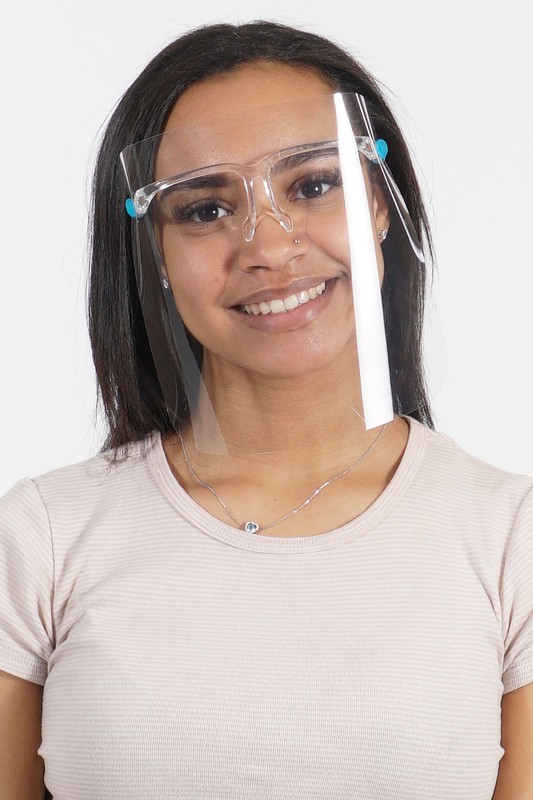In the realm of personal protective equipment (PPE), face shields play a pivotal role in safeguarding individuals against various airborne hazards and contaminants. Amidst the global health crisis, the significance of face shields has surged, not only in medical settings but also in everyday life.
The Significance of Face Shields
Face shields stand as essential tools in safeguarding individuals against various airborne hazards and contaminants. As the world navigates through unprecedented challenges, the significance of face shields cannot be overstated. Let’s explore why these protective gears are vital for ensuring safety and security in diverse environments.
Comprehensive Protection
Face shields provide extensive coverage, safeguarding not only the mouth and nose but also the eyes and face. Unlike traditional masks, which focus primarily on respiratory protection, face shields offer a holistic shield against droplets, splashes, and other airborne particles.
Versatility Across Industries
From healthcare facilities to manufacturing plants, retail establishments to educational institutions, face shields find applications in diverse settings. Their versatility makes them indispensable for frontline workers, essential personnel, and everyday individuals seeking additional protection.
Comfort and Reusability
One of the standout features of face shields is their comfort and reusability. Unlike masks, which can feel restrictive or uncomfortable, face shields offer a breathable and spacious alternative. Additionally, many face shields are designed for multiple uses, reducing waste and promoting sustainability.
Choosing the Right Face Shield
Selecting the ideal face shield is crucial for ensuring both protection and comfort in various settings. With numerous options available, it’s essential to consider several factors to make an informed decision.
Material Quality and Durability
When selecting a face shield, prioritize materials known for their durability and resistance to impact and chemicals. Polycarbonate and PETG are popular choices, renowned for their strength and reliability.
Clarity and Visibility
Opt for face shields with exceptional optical clarity to ensure clear vision and minimal distortion. This is particularly important for tasks requiring precision and attention to detail, such as medical procedures or laboratory work.
Adjustable Features for Optimal Fit
Look for face shields with adjustable straps or headbands to accommodate different head sizes and shapes. A secure and comfortable fit is crucial for prolonged wear and maximum protection.
Regular Inspection for Wear and Tear
Periodically inspect face shields for signs of wear and tear, such as scratches, cracks, or loose components. Replace damaged shields promptly to ensure continued protection.
Coverage and Design
Consider the extent of coverage provided by the face shield and its design features. Choose shields that offer ample coverage, extending beyond the face to protect the eyes, nose, and mouth effectively. Additionally, assess the shield’s design for features such as anti-fog coatings or ventilation ports, which can enhance wearer comfort and visibility, especially during extended wear.
Compliance with Safety Standards
Ensure that the face shield complies with relevant safety standards and regulations. Look for certifications such as ANSI/ISEA Z87.1 for impact resistance and ANSI/ISEA Z87.1+ for additional protection against droplets and splashes. Compliance with safety standards ensures the shield’s effectiveness in providing adequate protection against potential hazards.
User Feedback and Recommendations
Consider seeking feedback from users and professionals in relevant industries to gain insights into the performance and reliability of specific face shield models. User reviews and recommendations can provide valuable firsthand experiences, helping you make a more informed decision.
Why Face Shields Matter
Personal protective equipment (PPE), offering a myriad of benefits that make them indispensable in various contexts. Let’s delve into why face shields matter and why they play a pivotal role in safeguarding individuals against airborne hazards and contaminants.
Enhanced Protection
Face shields offer comprehensive protection by covering the entire face, including the eyes, nose, and mouth. This feature sets them apart from other PPE, such as masks, which primarily focus on mouth and nose coverage.
Versatility
From healthcare professionals to essential workers and the general public, face shields cater to diverse needs. They are suitable for various environments, including hospitals, laboratories, manufacturing facilities, and public spaces.
Comfort and Reusability
Unlike masks that may cause discomfort or breathing issues, face shields provide a comfortable fit without obstructing breathing. Moreover, many face shields are reusable, contributing to sustainability efforts and cost-effectiveness.
Enhanced Safety in High-Risk Environments
Face shields are especially valuable in high-risk environments such as healthcare facilities, laboratories, and industrial settings, where individuals may encounter hazardous materials or pathogens. By acting as a physical barrier, face shields help minimize the risk of exposure to potentially harmful substances, thereby enhancing safety and mitigating the spread of infectious diseases.
Choosing the Right Face Shield
Selecting the appropriate face shield is paramount to ensuring optimal protection and comfort in various environments. With a plethora of options available in the market, it’s essential to consider several factors when making your decision.
Material Quality and Durability
Start by assessing the material used in the construction of the face shield. Opt for shields crafted from high-quality materials known for their durability and resistance to impact and chemicals. Polycarbonate and PETG are popular choices due to their exceptional strength and reliability, ensuring long-lasting protection against hazards.
Clarity and Visibility
Clear vision is essential when wearing a face shield, especially in tasks requiring precision and attention to detail. Prioritize shields with excellent optical clarity to maintain clear visibility and minimize distortion. This feature is particularly crucial in professions such as healthcare, where visual acuity is paramount for accurate diagnosis and treatment.
Adjustable Features for Optimal Fit
Ensure that the face shield provides a secure and comfortable fit by opting for models with adjustable features. Look for shields with adjustable straps or headbands, allowing for customization to accommodate different head sizes and shapes. A properly fitted face shield not only enhances comfort but also ensures maximum coverage and protection.
Coverage and Shield Design
Consider the coverage offered by the face shield and its design features. Opt for shields that provide ample coverage, extending beyond the face to shield the eyes, nose, and mouth effectively. Additionally, assess the shield’s design for features such as anti-fog coatings or ventilation ports, which can enhance wearer comfort and visibility, especially during prolonged use.
Compliance with Safety Standards
Verify that the face shield complies with relevant safety standards and regulations, ensuring its effectiveness in providing protection against airborne hazards and contaminants. Look for certifications such as ANSI/ISEA Z87.1 for impact resistance and ANSI/ISEA Z87.1+ for additional protection against droplets and splashes.
User Reviews and Recommendations
Lastly, consider seeking feedback from users and professionals in relevant industries to gauge the performance and reliability of different face shield models. User reviews and recommendations can provide valuable insights into the practicality, comfort, and overall effectiveness of specific products in real-world scenarios.
Maintenance and Care Tips
Regular Cleaning
Clean face shields thoroughly after each use with soap and water or disinfectant wipes to remove any residues or contaminants.
Proper Storage
Store face shields in a clean, dry place away from direct sunlight or extreme temperatures to prevent degradation of materials.
Inspection
Regularly inspect face shields for signs of wear and tear, such as scratches or cracks, and replace them if necessary to maintain optimal protection.
Conclusion
Face Shields face shields are indispensable tools for safeguarding against airborne hazards and contaminants, especially in high-risk environments such as laboratories. Their comprehensive protection, versatility, and comfort make them essential accessories for individuals across various industries and settings, including those in need of laboratory supplies in Sydney. By choosing the right face shield, practicing proper maintenance, and prioritizing safety protocols, we can enhance protection and promote well-being in our communities.




